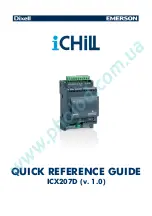
8013: APPLICATION
Easy Programmability
The 8013 can be easily controlled by several programming tech-
niques and languages because it is a VXI-11.3 instrument. If you
program with LabVIEW, National Instruments' VISA supports VXI-
11.3 instruments like the 8013. NI's Measurement and Automation
Explorer treats the 8013 as a TCP/IP compliant device.
Agilent's VISA library supports VXI-11.3 instruments and the
Agilent Connection Manager sees the 8013 as a TCP/IP instru-
ment.
If you are a Visual Basic, VB.Net or C/C++ programmer, you can
write your program to call Agilent's or National Instruments' VISA
or Agilent's SICL library in the Windows environment.
If you use LINUX or any other flavor of UNIX like SunOS,
IBM-AIX, HP-UX, or Apple's OS X, you can communicate with the
8013 through RPC over TCP/IP. RPC (or Remote Procedure Calls)
provides an invisible communication medium for the developer.
The VXI-11 specification provides an RPCL (Remote Procedure
Call Library) that can be used by virtually any operating system to
control the 8013.
If you program with Java then you can write a 8013 control pro-
gram that can be easily moved to many different operating systems.
The Java jGpibEnet project on SourceForge was developed using an
ICS 8065 Controller.
ICS has several Application Notes that describe how to program VXI-
11 devices. These Application Notes are available at http://www.
icselect.com/ab_note.
VXI-11 Advantages
The 8013 is a VXI-11.3 compliant interface and fits in with todays
new test equipment architectures that use TCP/IP networks. Because
the 8013 is VXI-11.3 compliant it can be controlled by a very wide
range of applications and programming languages. VXI-11 is a
communication standard developed in conjunction with the VISA
Specification. An VXI-11.3 interface like the 8013 can be controlled
in Windows systems by programs that make VISA or SICL library
calls and in UNIX/LINUX or similar operating system with RPC
calls. The VXI-11 specification provides an RPCL (Remote Procedure
Call Library) that can be used by virtually any operating system to
control the 8013. While a VXI-11 .3 interface like the 8013 will oper-
ate in an LXl system, LXI devices are limited to Windows operating
systems with VISA libraries and require IVI drivers.
Easy Network Setup
There are three ways to set the 8013's network settings. The 8013
includes an internal WebServer that with HTML web pages that can
be accessed by a web browser from any computer. The web pages let
any user change the 8013's network settings. Secondly, ICS supplies
a windows based configuration utility that walks a user through the
network setup process. The third method is to use ICS's defined RPC
calls to change the 8013's network settings.
Interactive Keyboard Control Program
The 8013 includes ICS's VXI-11 Keyboard program for Windows
which provides interactive control of VXI-11 instruments from the
computer keyboard without having to write a program. The VXI-11
Keyboard program is the ideal utility program for configuring and
testing the 8013's connections or for trying out commands before
using them in a program.
8013 Welcome Page
8013 Configuration Page
With the VXI-11 Keyboard program you can find and link to
the 8013 and control its digital interface. Besides reading and
writing data strings, the VXI-11 Keyboard also has controls for
Device Clear, Device Trigger, and Serial Poll and for executing
command loops.
8013 Connections
The 8013 has three connectors: Digital Interface, Ethernet
connection and J3 for power.
The Digital Interface connector, J1, is a 150-pin connector
with 3 rows of 50 pins/row on 0.1 inch centers. The standard
8013 board has vertical male pins on the component side of the
board. Mating female connectors are available with two lengths
of solder tails. A small Connector Board is also available for the
8013 that breaks the 128 lines into four 32 line groups on 36-pin
flat-ribbon headers. The Connector Board also includes a 10-pin
header with LED drive signals for remoting the 8013's LEDs. The
115650 Connector Board plugs into the 8013's vertical connector
and sits on top of the 8013 board.
When piggybacked on a larger PC board, the 8013 adds less
than 0.750 of height to the PC board assembly.

























